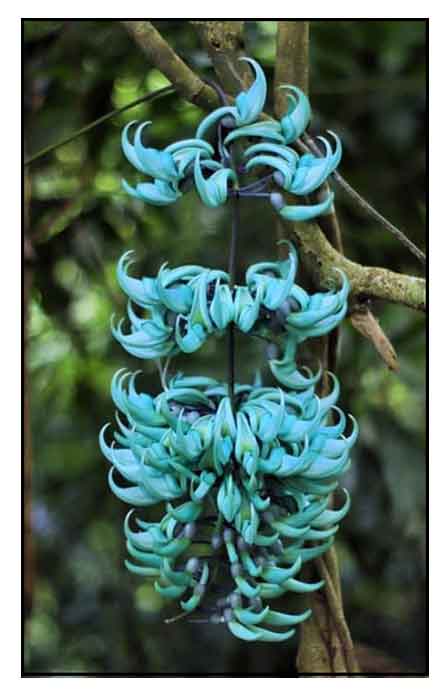Gen info
 - Strongylodon macrobotrys was discovered in 1841 on the jungle slopes of Mt. Makiling, Luzon, Philippines, by the United States Exploring Expedition led by7 US Navy Lt. Charles Wilkes. (4) - Strongylodon macrobotrys was discovered in 1841 on the jungle slopes of Mt. Makiling, Luzon, Philippines, by the United States Exploring Expedition led by7 US Navy Lt. Charles Wilkes. (4)
- Etymology: The genus name Strongyodon derives from Greek "strongylos" meaning "round", and "odon" meaning teeth, referring to the rounded teeth of the calyx. The species epithet "macrobotrys" means "large grape cluster" referring to the fruit.
(4)
- With its long cascading translucent jade-green flowers
beneath a canopy of pale green foliage.. it is one of the most beautiful and elegant of tropical climbers. (6)
- The plant has been grown at Kew for many years but had never produced seed, until 1995. Scientists from the Jodrell Laboratory managed to pollinate flowers successfully so that seeds developed. (5)
Botany
Strongylodon macrobotrys, locally known as Tayabak, is a species of leguminous liana (woody vine), with stems that can reach up to 18 m long. Foliage is pale green, consisting of three leaflets. Leaves are usually dark green, up to 25 cm long. Vine stalk is relatively wide, about 2.5 cm wide. Inflorescences are only produced by mature vines. Claw-shaped flowers are borne in pendent trusses or pseudoracemes of 75 or more flowers and can reach as much as 3 m long. Flowers vary from blue-green to mint green in color, similar to colors of minerals like turquoise and jade. Seed pods are short oblong, and fleshy, up to 15 cm long, containing up to 12 seeds.
Distribution
- Native of the Philippines.
- Grows wild in damp forests, beside streams or ravines of Luzon and Mindoro.
- Destruction of rainforests in the Philippines threatens the species in the wild.
- Ornamental cultivation.
- IUCN Red Listed as vulnerable.
Constituents
- Chemical investigation of dichlormethane extracts isolated taraxerone (1), stigmasterol (2), ß-sitosterol (3), and triglycerides (4) from the stems; 2,3, and ß-stigmasteryl 3-O-ß-D-glucopyranoside (5) from the flowers; and polyprenol (6), lutein (7), squalene (8), and chlorophyll (8) from leaves. (see study below) (5)
Properties
- Pollinated by birds and bats. Flowers attracts a species of wasp, and are home to a species of butterfly. (4)
Parts used
Parts used.
Uses
Edibility
- While seed pods of the legume species are technically edible, the plant is not for consumption. It is cultivated as an ornamental species.
Folkloric
- No reported folkloric medicinal use in the Philippines.
Others
- Decorative / Ornamental:- Cultivated in gardens trellises for its spectacular festoon of green flowers resembling lobster claws. In Hawaii, used in the making of leis.
Studies
• Flower Color Chemistry/ Malvin:Saponarin: The flower contains an anthocyanin (malvin) and a flavone (saponarin) in an approximate 1:9 molar ratio (malvin:saponarin). The characteristic flower color is an example of co-pigmentation of malvin and saponarin, with colors varying according to pH. The characteristic blue-green is the result of co-pigmentation of anthocyanin with flavone in alkaline cell sap (pH 7.9), In slightly alkaline condition, flavone shows a strong yellow color, which gives a greenish tone to the flower color. (1)
• Anthocyanin / Malvin: The flower's luminous blue green color attracts bats for pollination. Study investigated the chemical basis of the flower color of Strongylodon macrobotrys. The flower yielded an anthocyanin, malvin, and a flavone (saponarin) at 1:9 molar ratio.
• Saponins: Study of seeds of Strongylodon macrobotrys isolated two saponins as dimethyl esters with structures identical with the dimethyl esters of pseudo-ginsenoside-RP1 and zingibroside-R1.
• Biologic Activities and Anti-Cancer Properties of Constituents: Study of stems, flowers and leaves yielded 9 constituents. While no biologic activity tests were conducted on the isolated compounds, all nine have reported diverse biologic activities, (1) Taraxerone: Reported to exhibited antioxidant properties, anti-Giardia lambia, anti-leishmanial, antiviral activities and anti-tumor activity on K562 leukemic cell line. (2) Stigmasterol: Efficacy against Ehrlich ascites carcinoma bearing mice and has lowering effect on cholesterol. (3) ß-sitosterol: Growth inhibitory effects on human breast MCF-7 and MDA-MB-231 adenocarcinoma cells; potential anti-colon carcinogenesis effect and down-regulation of Akt in MCA-102 murine fibrosarcoma cells. (4) Triglycerides: Exhibited antimicrobial activity. Linoleic acid has shown anticarcinogenic effect in animal models and shown to reduce risk of colon and breast cancer. (5) ß-stigmasteryl 3-O-ß-D glucopyranoside: ß-sitosteryl and stigmasteryl glucosides have been reported as selective DNA polymerase B lyase inhibitors and potentiators of bleomycin cytotoxicity in A549 human lung cancer cell line. (6) Polyprenols: Hepatoprotective effects in CCl4-induced toxicity in rats and antitumor activity. (7) Dietary lutein: Inhibition of tumor growth by selectively modulating apoptosis and by inhibiting angiogenesis. (8) Squalene: Suppression of colonic ACF formation and crypt multiplicity, which suggest chemopreventive activity against colon carcinogenesis. (9) Chlorophyll: Studied for wound healing and anti-inflammatory properties and use as effective agent in photodynamic cancer therapy and chemopreventive effects in humans. (5)
Availability
Wild-crafted.
Seeds in the cybermarket.
|

![]()



 - Strongylodon macrobotrys was discovered in 1841 on the jungle slopes of Mt. Makiling, Luzon, Philippines, by the United States Exploring Expedition led by7 US Navy Lt. Charles Wilkes. (
- Strongylodon macrobotrys was discovered in 1841 on the jungle slopes of Mt. Makiling, Luzon, Philippines, by the United States Exploring Expedition led by7 US Navy Lt. Charles Wilkes. (